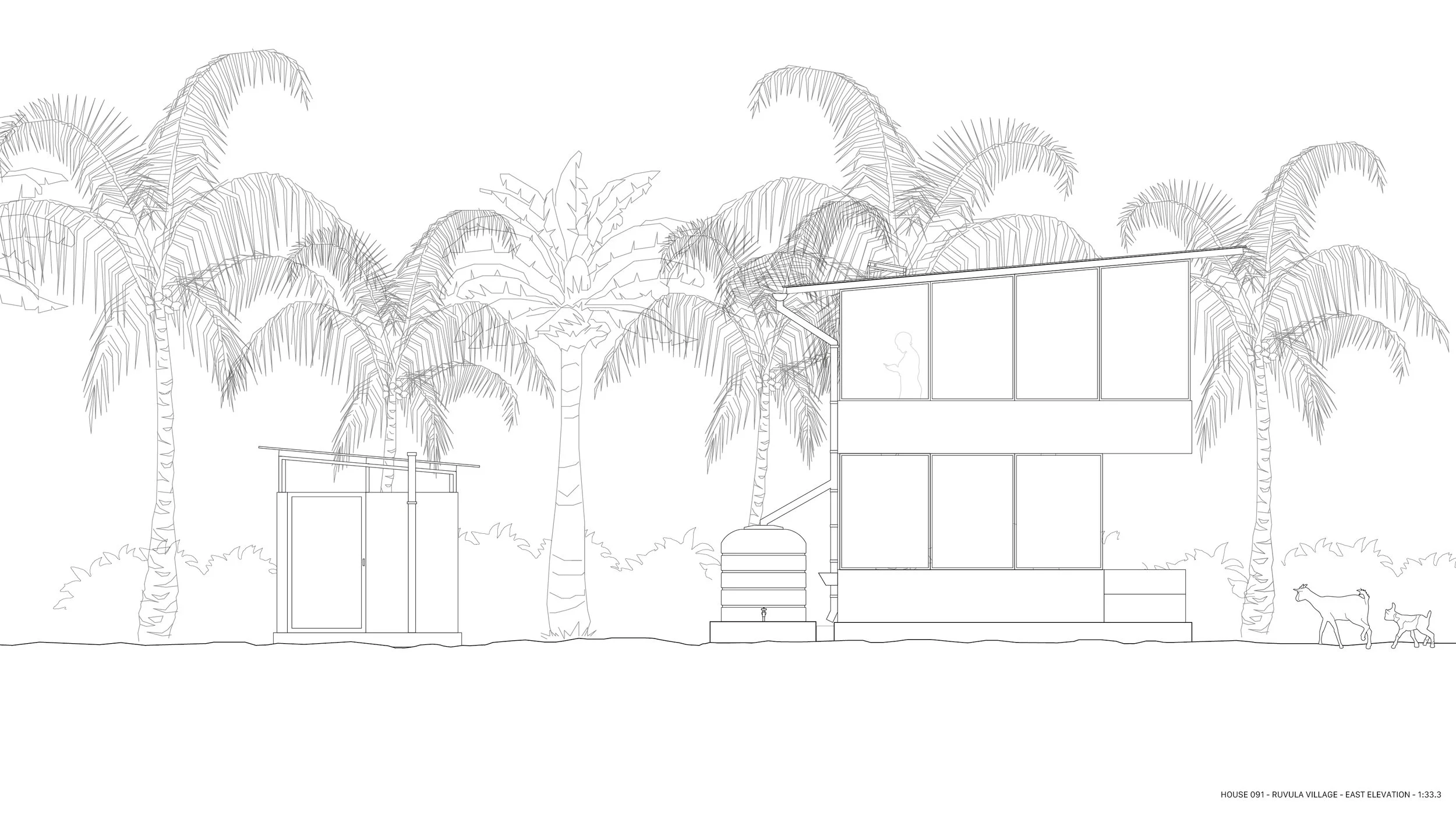Mtwara, Tanzania, 2021. Photo: Lorenz von Seidlein
The Star Homes Project has been in development for over a decade, exploring ways to develop novel, low-cost, comfortable and insect-proof housing to enhance the health of people in rural areas of Sub-Saharan Africa. The project consists of 110 identical, single family ‘Star Homes’ constructed across 55 different villages in rural Mtwara, one of the more underdeveloped regions of Tanzania, with a high incidence of malaria, respiratory tract infections, and diarrhoea. These houses form the basis of a trial, which aims to provide robust data to show whether improved housing can improve family health.
Both upgraded and vernacular house styles in Sub-Saharan Africa appear to predispose residents to contracting vector borne, enteric, and respiratory diseases. Thick walls absorb heat during the day and radiate it into the home at night, which deters occupants from using bednets, therefore increasing the risk of malaria transmission. Ground-level bedrooms have higher mosquito densities, which also increases the risk of contracting vector borne infections. Cooking is generally done on open fires within poorly ventilated spaces, which can lead to respiratory health issues, especially among women and children. Surfaces are generally made from compacted earth that is difficult to clean, which alongside open pit latrines, inadequate water supply and minimal sanitation, leaves families susceptible to diarrhoea and other enteric infections. The health consequences of building in this way are most severely felt in rural regions, such as Mtwara in southern Tanzania, where families have limited access to public health services.
Mtwara, Tanzania, 2022. Photo: Julien Lanoo
The Star Homes* have been designed to be easily scalable and optimise resource use to reduce their environmental impact and build cost. Unlike most rural Tanzanian housing, our prototype house is two stories high. This reduces the area of the foundation and roof, which are typically the most expensive and material intensive components of a house. Many houses in rural Tanzania collapse in the rainy seasons, which is often as a result of the poor quality of their foundations. Each Star Home* is built on a raised concrete plinth, cast is a single pour to improve strength and backfilled with compacted earth from the latrine pit to reduce concrete use and the need for hardcore. The structural frame of each house is built using 0.75mm thick prefabricated light gauge steel (LGS) members bent in two directions for extra strength, assembled into panels which can be erected in under 2 days by a local team. Walls appear solid but are in fact hollow, consisting of two thin layers of cement render on wire mesh. The result is a home that uses 70% less concrete compared with a typical concrete block design and has 40% less embodied energy.
Reducing operational energy is a key aspect of the design due to the off-grid nature of the sites and limited financial resources of the new house owners. A custom designed, prefabricated stove uses a third less fuel compared with traditional cooking methods, whilst expelling smoke outside. Replaceable shadenet facade panels prevent mosquito entry and allow the building to be passively ventilated and cooled, resulting in on average a 2.5 degree drop in indoor temperature at night compared with a local mud house. A 40W solar panel provides lights in each room and USB charging. Rainwater is collected from the roof and stored in a 2000L tank via a first flush system made from off the shelf components, which provides free clean drinking water. The project aims to build capacity in some of the poorest communities in the world through providing robust and affordable housing and teaching new construction skills. All components and labour have been sourced from within Tanzania and constructed by a local team. Beyond the building’s lifespan, the foundation can be reused and the LGS frame and facade panels can be reused or recycled.
The Star Home is designed by an interdisciplinary team of architects, public health specialists and entomologists and combines a series of design interventions to improve family health into a single house. A detailed process was undertaken to select the recipients and location of the Star Homes. In 2019, prior to the start of the construction, a survey of the rural villages in Mtwara was conducted. Households that wanted to participate and met the study inclusion criteria (such as having children under 13 years of age in the household) could enter a lottery to win a Star Home built on their land. The lottery was conducted in an open and transparent manner to select the recipients. Following the construction of all 110 Star Homes in June 2021, families moved in and began participating in the trial, in which children under 13 years sleeping in the Star Homes and neighbouring traditional homes will be followed over a three-year period, to detect episodes of malaria, acute respiratory infections, and diarrhoea. Alongside the trial, a team of architects, entomologists and social scientists will assess the performance and acceptability of the house design, using mixed methods involving in-depth interviews, focus group discussions, house walk throughs and a questionnaire-based surveys. Light traps will be used to collect mosquitoes and flies in the Star Homes and the control homes, to assess the amount of malaria carrying mosquitos entering the houses. The study is due to be completed by 2024.
Mtwara, Tanzania, 2022. Photo: Julien Lanoo
Photography: Lorenz von Seidlein, Jakob Knudsen, Otis Sloan Wood and Hannah Sloan Wood, Courtesy of Ingvartsen Architects, Julien Lanoo.






















